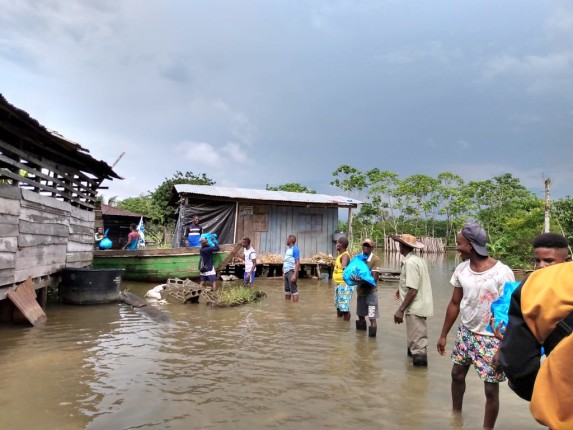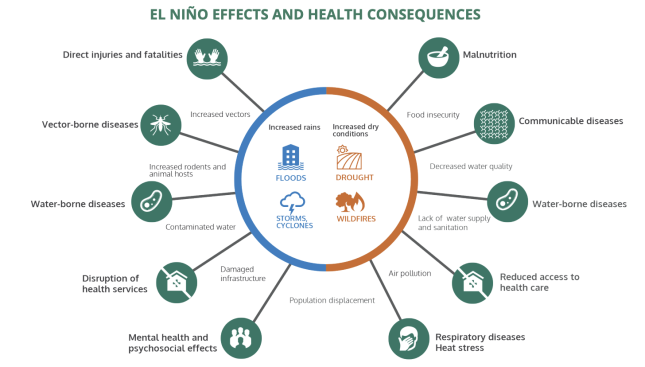-
Understanding El Niño’s Broad and Pervasive Impacts is Essential To Mitigation
July 10, 2023 By Danielly de Paiva Magalhães
Scientists from the National Oceanic and Atmospheric Administration (NOAA) have predicted an El Niño event between late 2023 and early 2024. El Niño is a complex climate phenomenon characterized by unusually warm sea surface temperatures in the central and eastern Pacific Ocean near the equator that typically happens every two to seven years. This phenomenon amplifies the likelihood of severe weather events in specific regions due to changes it creates in atmospheric circulation patterns, which escalate and initiate consequences for the environment, economy, and human health.
El Niño also has proved to be an intriguing yet challenging phenomenon that constantly keeps scientists and meteorologists on their toes. Each event tends to differ from the previous ones. NOAA’s researchers predict that there is an 84 percent chance of the next El Niño being moderate and a 56 percent chance of it being strong. Because the El Niño of 2016 (2014-16) was a strong one, the ocean experienced its highest recorded surface temperature. Since then, the average temperature of the oceans has been breaking records year after year, even with the three subsequent years of La Niña, which is an opposite climatic pattern in the Pacific Ocean that makes the sea temperature colder than the average. Not only do such marine heatwaves disrupt the essential balance of oxygen and nutrients to sustain aquatic life, but scientists assert that the present historical warming of the oceans is irreversible over the coming century.
The interplay between climate change and El Niño is intricate and multifaceted. In particular, the oceans’ ability to absorb heat from human activities plays a significant role in their combined effects. (The increased temperature of the ocean reduces its capacity to absorb CO2 from the atmosphere).
Yet while El Niño is a naturally occurring phenomenon predating the industrial revolution, there is growing evidence that climate change can impact its frequency, intensity, and characteristics by altering the underlying conditions in which this climate pattern develops. Understanding and predicting these interactions are essential steps to assess the risks they pose. They also offer a path to develop effective adaptation and mitigation strategies, including disaster preparation to protect populations and vulnerable communities and health preparedness.
Assessing Major Effects By Region
The strong El Niño event of 2015-2016 impacted over 60 million individuals in a number of regions, particularly in Eastern and Southern Africa, Latin America and the Caribbean, and Asia-Pacific. The effects of El Niño vary depending on the location and can include water scarcity, crop failure, and disruptions to livelihoods. Severe drought conditions and food insecurity vexed Eastern and Southern Africa, including Ethiopia, Somalia, and Kenya. Latin American countries like Peru, Ecuador, and Colombia experienced heavy rainfall and flooding, resulting in infrastructure damage and population displacement. Droughts, forest fires, and crop losses challenged the Asia-Pacific, Indonesia, the Philippines, and Australia.
Many of these regions are already grappling with the impacts of climate change, financial challenges resulting from the Covid-19 pandemic, and existing inequalities. So it is crucial to approach the exacerbation of these disparities by El Niño with caution. Financial support and proactive measures are needed to mitigate its future impact on vulnerable communities.
Tracking Consequences on Health

Global disease outbreaks in El Ninõ years increased by around 2.5 to 28 percent as compared to periods when the climate pattern was absent. Extreme weather events and disasters also elevate the susceptibility to diseases transmitted by vectors and rodents (such as dengue, malaria, chikungunya, zika, and leptospirosis), as well as those caused both by contaminated food and water (including cholera, cryptosporidium, rotavirus, E.coli infection, giardia, shigella, typhoid, hepatitis A), and biotoxins (such as ciguatera and shellfish poisoning).
Floods and droughts pose significant challenges as well, potentially affecting agriculture, triggering food insecurity and, increased malnutrition, which enhance the vulnerability to infectious diseases, mainly in vulnerable places. Moreover, higher temperatures and increased rainfall often create favorable conditions for mosquito breeding, extending the reach of diseases like dengue, chikungunya, Rift Valley fever, Zika, and malaria to previously unaffected regions.
The Greater Horn region in Africa offers one recent example. A severe drought there for three years left over 16.2 million people lacking access to clean water in Ethiopia, Somalia, and parts of Kenya, coupled with 129,000 facing starvation. Then, in March of this year, the region was affected by heavy rains that killed dozens and affected 300,000 people. These countries not only are battling measles—a deadly disease—and cholera, but they are also in the grip of concurrent outbreaks of hepatitis, meningitis, and dengue (which was declared for the first time in Khartoum in February of this year). The sub-Saharan region was also recently invaded by the malaria vector Anopheles stephensi, which threatens control efforts across the continent—and particularly in cities where malaria transmission has historically been low.
Latin America offers another case study. Peru witnessed intense rainfall this past March caused by ocean warming and the presence of the Yaku cyclone. Although the cyclone lasted a few weeks, high sea temperatures have persisted, resulting in heavy rains and increased temperatures in coastal cities that prolonged the summer season. The National Center for Epidemiology, Prevention, and Control of Diseases (CDC – Peru) warned that the increased rainfall can lead to a higher risk of diseases such as acute respiratory infections (ARI), acute diarrheal disorders (ADD), dengue, leptospirosis, plague, and malaria in various parts of Peru. The threat from dengue in Peru also is already escalating beyond control and could be aggravated further by El Ninõ.
A higher risk of severe forest fires is also associated with the extended periods of drought linked with El Niño, which can result in degraded air quality and respiratory problems among nearby populations. Inhalation of fine smoke particles from these fires can harm the lungs—a particular concern for vulnerable groups such as children, pregnant individuals, elders, and those with weakened immune systems or pre-existing conditions. The estimated annual mortality attributed to air pollution from fire smoke was 262,000 during La Niña, but increased to 532,000 during El Niño.
The wildfires’ severity and associated health effects highlight the wide-ranging impacts of such natural disasters. Consider the far-reaching consequences seen during the 2019-2020 Australian bushfire season, during neutral ENSO (El Niño-Southern Oscillation) conditions. Despite efforts to minimize exposure to landscape fire smoke, the smoke haze from Australia’s blazes extended over 10,000 kilometers to countries like Argentina and Chile. The wildfires resulted in significant health impacts, including an estimated 417 excess deaths, 1,124 hospitalizations for cardiovascular diseases, and 2,027 for respiratory problems. In June of this year, the dry conditions and hotter weather in Canada led to nearly 400 forest fires in provinces like Ontario, Quebec, and Nova Scotia, surpassing the 10-year average of 197 fires. Consequently, air quality alerts already have been issued across various states in the Midwest, mid-Atlantic, and Northeast regions of the U.S. over a period of weeks in late spring and early summer of 2023.
The combination of the next predicted El Niño with a worsening climate crisis is expected to drive global temperatures to unprecedented levels. Prolonged heat waves with high humidity can result in heat exhaustion and heatstroke, particularly affecting workers. Dehydration, cardiovascular issues, and respiratory difficulties are heightened during heat waves, with vulnerable populations and those with chronic illnesses at higher risk. Heatwaves have been linked to increased mortality rates, particularly among the elderly. More than 1,300 deaths per year in the U.S. come about due to extreme heat conditions.
What Can Be Done to Mitigate?
In response to concerns regarding the amplified impact of extreme weather events, the Pan American Health Organization (WHO’s Office for the Americas) launched a pocketbook in 2020. This guide was specifically designed for health professionals to identify weather-related diseases and side effects, and implement suitable management strategies. Among these include offering guidance to vulnerable populations, providing updated information on the interplay between specific medications and climate-sensitive health conditions, and assessing the potential implications of climate change on healthcare services.
Yet there are limited timeframes to prepare for—and address—the consequences offered by the next El Niño event. Solutions are not straightforward, and they vary according to location and circumstances. But there are some general recommendations that should be considered.
First, it is crucial to establish early warning systems to develop and implement comprehensive disaster management plans that address the risks associated with El Niño, such as floods, landslides, hurricanes, cyclones, and wildfires. Raising awareness in communities about the potential impacts of this climate pattern is central to this effort, while educating these populations about available emergency resources and the appropriate response measures to follow also is important.
During the summer season in Brazil, for instance, various campaigns are conducted through television, radio, and other media platforms to educate citizens about dengue symptoms and help propagate methods to prevent mosquito breeding. These awareness campaigns focus on the importance of eliminating mosquito breeding sites, using insect repellents, and practicing personal protective measures to reduce the risk of dengue transmission. Similar preventive measures also can be applied to other preventable diseases, such as cholera and leptospirosis.
It also is paramount to ensure the continuity of health services, prioritize patient care, and maintain the safety of healthcare facilities and staff. Real-time utilization of meteorological data, enhancing cooperation between health units, preparing contingency plans for various scenarios (such as drought, flood, cyclone, and energy shortages), and ensuring the functionality and safety of healthcare facilities during extreme weather events are essential measures to be taken. By implementing these strategies, health services can better withstand and respond to the challenges posed by extreme weather events, ultimately protecting the well-being of individuals and communities.
Ongoing support from the World Health Organization (WHO) is also part of this important effort, including monitoring El Niño progression, assisting with contingency planning, and guiding the preparation of hospitals and clinics for climate-related challenges.
Yet meeting this challenge will take more than assistance from large organizations. It also requires collaboration across public and private sectors, including meteorology, health, environment, infrastructure, and agriculture, to develop sustainable responses and practices. By working together and taking these measures, countries in the regions that are most vulnerable to the impacts of El Niño can better prepare for and minimize them.
Danielly de Paiva Magalhães is an Environmental Health Researcher at the Oswaldo Cruz Foundation (Fiocruz), Brazilian Ministry of Health, Brazil.
Sources: Advances in Atmospheric Sciences; CBC; Environmental Health Perspectives; EPA; Journal of the American Heart Association; The Lancet; Mo Ibrahim Foundation; Nature; NOAA; PAHO/WHO: Parasites & Vectors; UN
Photo Credits: Colombia’s Caribbean coast was battered by heavy rains and saw intense flooding during hurricanes Eta and Iona, courtesy of Flickr user EU Civil Protection and Humanitarian Aid; WHO, 2016.
 A Publication of the Stimson Center.
A Publication of the Stimson Center.




